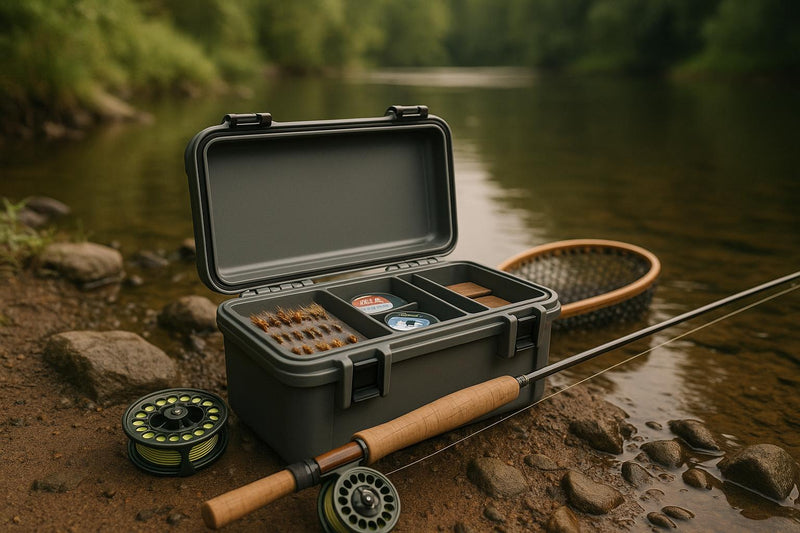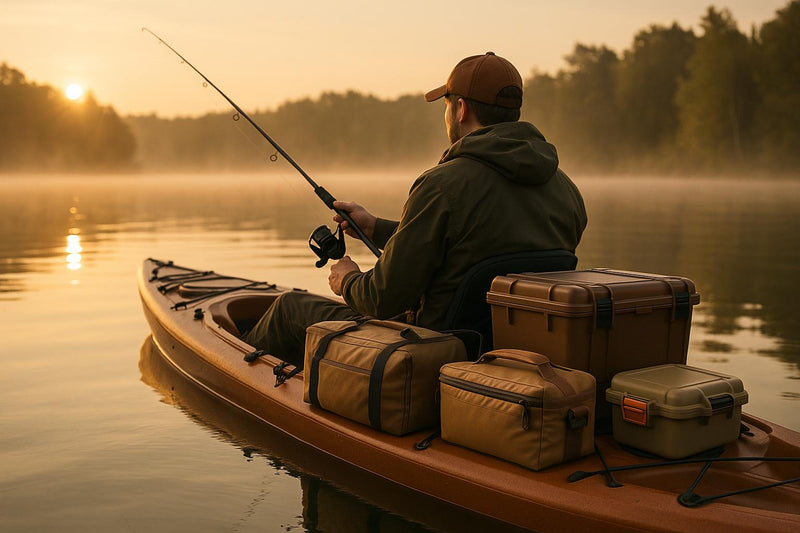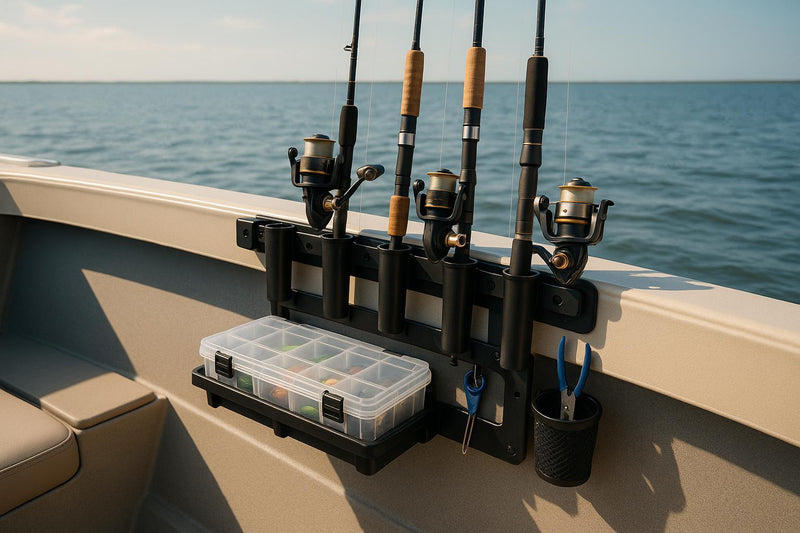Fishing shorts equipped with waterproof membranes are designed to keep you dry and comfortable during long hours on the water. These membranes are engineered to block external water while allowing sweat vapor to escape, ensuring breathability. Here's a quick breakdown:
- Purpose: Protect against water from rain, splashes, and waves while preventing overheating.
- Materials: Commonly made with ePTFE or polyurethane (PU), each offering unique benefits. ePTFE excels in breathability, while PU is more resistant to contaminants like saltwater and oils.
- Construction: Available in 2-layer, 2.5-layer, and 3-layer designs, balancing weight, comfort, and durability.
- Benefits: Improved waterproofing, breathability, durability, and comfort. Ideal for fishing in wet or humid conditions.
- Care Tips: Use gentle washing methods, avoid fabric softeners, and reapply durable water-repellent (DWR) coatings as needed.
These membranes are a game-changer for anglers, combining moisture protection with features like quick-dry fabrics, stretch panels, and reinforced stitching for durability. For the best performance, choose fishing shorts with the right waterproof and breathability ratings based on your fishing environment.
How Waterproof Membranes Are Built
Waterproof membranes are engineered to keep fishing shorts both dry and comfortable. These membranes rely on specialized materials and manufacturing techniques that determine how effective, durable, and comfortable they are.
Materials and Technology in Waterproof Membranes
The secret to these membranes lies in the materials used. Two key players - expanded PTFE (ePTFE) and Polyurethane (PU) - are the foundation of waterproof technology.
According to Dryguy Waterproofing:
"ePTFE membranes feature intricate web-like structures only about 10 microns thick, containing billions of pores. These pores are approximately 20,000 times smaller than raindrops, rendering ePTFE hydrophobic (water-repellent)."
This design lets sweat vapor escape while blocking liquid water, a crucial feature for long fishing sessions. However, ePTFE has a weakness: it can degrade when exposed to contaminants like dirt and oils. To combat this, manufacturers often make it oleophobic, reducing the risk of damage.
Polyurethane membranes, on the other hand, take a different approach. They come in two main forms: monolithic (solid) and microporous. Monolithic PU membranes use molecular wicking, absorbing moisture from the inside and diffusing it outward for evaporation. Dryguy Waterproofing explains:
"PU films offer good stretch, complete waterproofing, and maximum comfort. They are often lighter and more compact than ePTFE laminates, accommodating stretch in garment designs and proving highly durable, suitable for demanding environments."
This makes PU membranes a great choice for active fishing. They’re less affected by saltwater, fish slime, or sunscreen. However, their breathability depends on temperature and humidity, performing best in cooler, drier conditions.
Layering Methods: 2-Layer, 2.5-Layer, and 3-Layer Builds
Beyond materials, layering techniques play a big role in balancing durability and comfort. Waterproof membranes in fishing shorts are constructed using three main layering methods:
- 2-layer construction bonds the membrane directly to the outer fabric. It’s lightweight but typically requires a separate inner liner for comfort.
- 2.5-layer construction adds a thin protective coating or print on the membrane’s inner side. This eliminates the need for a full liner, providing a good balance of weight and durability.
- 3-layer construction sandwiches the membrane between an outer fabric and an inner liner. This design offers excellent durability and protection, making it ideal for heavy use.
Each method has its own trade-offs. For example, 3-layer designs provide consistent comfort and protection, but they’re heavier. Meanwhile, 2-layer options are lighter but may feel less comfortable until the liner warms up with use - a small compromise for those on extended fishing trips.
Lamination and Bonding to Fabrics
How the membrane is bonded to the fabric also impacts performance. Two main methods are used:
- Coating applies liquid polyurethane directly onto the fabric, which then cures into a waterproof layer. While this creates a strong bond, the coating can wear off in high-stress areas over time.
- Lamination uses heat and pressure to fuse a pre-formed membrane film to the fabric. This process preserves the unique properties of both layers and generally provides better breathability and long-term performance. However, delamination can occur if the bond fails.
For fishing shorts that endure constant stretching, contact with boat hardware, and exposure to saltwater, high-quality lamination is often the better choice. It helps maintain the membrane’s waterproof and breathable qualities, ensuring dependable protection during long days on the water.
Benefits of Waterproof Membranes in Fishing Shorts
Waterproof membranes take fishing shorts to a whole new level, delivering the kind of performance that fishing enthusiasts need. These materials offer exceptional protection, comfort, and durability, making them far superior to regular fabrics. Reel Comfort’s premium fishing shorts highlight these advantages, providing anglers with gear that can handle even the toughest conditions.
Waterproofing and Breathability
One of the biggest perks of waterproof membranes is their ability to block water while allowing moisture to escape. This means you stay dry from rain, splashes, or waves without dealing with the sticky, uncomfortable sensation of trapped sweat.
Picture yourself casting from a boat or wading through shallow water. Waterproof membranes keep liquid out while releasing sweat vapor, ensuring you stay dry and comfortable throughout your fishing adventure. This breathability is a game-changer, especially during active fishing when traditional waterproof gear might leave you feeling clammy and overheated. Membrane technology tackles this issue by maintaining airflow, helping regulate your body temperature and keeping you focused on the task at hand.
Durability and Abrasion Resistance
Fishing environments are notoriously rough on clothing. From sharp boat hardware to rocky surfaces and constant exposure to saltwater, your gear faces plenty of challenges. Waterproof membranes add an extra layer of protection, making fishing shorts more durable and resistant to wear and tear.
The multi-layer construction of membrane-equipped shorts provides better defense against punctures and abrasions. Whether you’re kneeling on rough surfaces, brushing against sharp edges, or handling hooks and tackle, the membrane acts almost like armor, especially in high-contact areas like the thighs and knees. This is particularly useful when dealing with boat gunwales or fishing equipment that might otherwise cause damage.
Saltwater, which can degrade many materials over time, poses less of a threat to waterproof membranes. Materials like polyurethane resist the corrosive effects of saltwater, ensuring your shorts maintain their performance even after repeated exposure. This durability means you won’t have to replace your gear as often, making waterproof fishing shorts a smart long-term investment.
Additionally, these membranes stand up to the constant movement involved in fishing. Whether you’re reaching for gear, navigating obstacles, or balancing on a moving boat, they maintain their integrity while allowing the flexibility you need.
Comfort and Ergonomic Design
Beyond durability, waterproof membranes also enhance comfort. They’re designed to support unrestricted movement, which is crucial when casting, netting fish, or navigating uneven terrain.
Reel Comfort’s Men’s Fishing Shorts showcase how waterproof technology can work alongside ergonomic features. For instance, water-resistant fabrics pair with removable thigh pads to provide targeted protection - whether it’s against rod butts during a long fight with a fish or hard surfaces when kneeling or sitting.
Features like four-way stretch panels ensure you can move freely without feeling restricted, a common issue with traditional waterproof clothing. This combination of flexibility and protection lets you focus on fishing, not your gear.
Anti-chafe seams are another thoughtful addition. Sealed seams prevent water from seeping in, while their strategic placement reduces friction, keeping you comfortable during long hours on the water. This attention to detail makes a noticeable difference, especially on extended fishing trips.
Waterproof membranes also improve storage options. Deep pockets and zippered compartments stay dry when the membrane is integrated into the garment, keeping your tackle, electronics, or personal items safe and accessible.
Finally, modern membrane technology is sleek and lightweight, so you don’t have to sacrifice style for functionality. These fishing shorts look like regular shorts but deliver reliable waterproof performance, making them a perfect blend of form and function.
Performance Ratings: Waterproofness and Breathability
When you're shopping for waterproof fishing shorts, you'll often see terms like "10,000mm waterproof" or "5,000g breathability." These numbers aren't just jargon - they’re standardized measurements that tell you how well the fabric performs in wet conditions and how effectively it allows moisture to escape. Knowing what these ratings mean can help you choose the right gear for your fishing adventures.
Understanding Waterproof Ratings (mm)
Waterproof ratings measure how much water pressure a fabric can handle before it starts to leak. The numbers represent the height of a water column in millimeters. For example, a fabric rated 10,000mm can withstand the pressure of a 10,000mm (about 33 feet) tall water column before water seeps through.
Testing involves gradually increasing water pressure on the fabric until it starts to leak. The maximum height the fabric can handle becomes its waterproof rating.
For fishing, the waterproof rating you need depends on the conditions:
- 5,000mm: Handles light rain and occasional splashes, perfect for calm lakes or sheltered bays.
- 10,000mm: Works well in moderate rain and boat spray, ideal for most saltwater fishing trips.
- 20,000mm and higher: Designed for heavy rain, big waves, and offshore fishing in stormy weather.
The key is to match the rating to your environment. If you fish in mild conditions, a lower rating might save you money while still keeping you dry. But if you're up against rough seas or sudden downpours, a higher rating ensures you stay comfortable and dry.
Reading Breathability Ratings (g/m²/24hr)
Breathability ratings tell you how much moisture vapor escapes through the fabric over 24 hours. The higher the number, the better the fabric is at letting sweat out, which helps you stay dry and comfortable during long days on the water.
This measurement is expressed in grams per square meter per day. For instance, a 5,000g/m²/24hr rating means 5,000 grams of moisture vapor can pass through one square meter of fabric in 24 hours.
Here’s how different ratings fit various fishing activities:
- 3,000–5,000g/m²/24hr: Suited for low-intensity activities like trolling.
- 5,000–10,000g/m²/24hr: Great for moderate activities such as casting or fishing from the shore.
- 15,000g/m²/24hr or higher: Ideal for high-intensity scenarios like surf fishing or wade fishing.
Breathability becomes especially important in hot or humid climates. Without proper moisture transfer, you might end up feeling overheated and sticky. High-quality fishing shorts use advanced membranes to balance waterproofing with breathability, ensuring you stay comfortable no matter the conditions.
What These Ratings Mean for Anglers
Understanding waterproof and breathability ratings is essential for picking the right gear. For light freshwater fishing, 5,000mm waterproofing and 5,000g/m²/24hr breathability are usually sufficient. But if you're dealing with heavy surf, boat spray, or unpredictable weather, look for shorts with 10,000mm waterproofing or higher and breathability around 8,000–10,000g/m²/24hr to manage sweat effectively.
For extreme conditions - like offshore fishing, stormy weather, or cold climates - you'll need top-tier performance. Gear with 20,000mm+ waterproofing and breathability of 15,000g/m²/24hr or more will provide the protection and comfort needed for demanding situations.
It’s worth noting that temperature can impact how these membranes perform. In cold weather, breathability might decrease, while extreme heat can strain waterproof coatings. High-quality fabrics are designed to maintain their performance across a range of temperatures, so you’ll stay dry whether you're fishing in a brisk spring breeze or under the summer sun.
When choosing fishing shorts, think about the conditions you face most often and pick gear that balances protection and comfort. For options that meet these performance standards, check out Reel Comfort's premium Fishing Shorts and Mens Fishing Shorts. These are designed with anglers in mind, ensuring you’re ready for whatever the water throws at you.
sbb-itb-cb0a783
Care and Maintenance of Waterproof Membranes
Taking care of your waterproof fishing shorts is about more than just keeping them clean - it's about preserving the technology that keeps you dry and comfortable. With proper maintenance, you can extend the life of your gear and ensure the waterproof membranes perform their best every time you need them.
Washing and Cleaning Techniques
How you wash your fishing shorts can make or break the longevity of their waterproof membranes. Start by zipping all compartments and fastening any flaps or straps to avoid snags or damage during washing.
Stick to water temperatures no hotter than 105°F (40°C) and use a gentle cycle with a liquid detergent specifically made for technical fabrics. Avoid powder detergents, fabric softeners, and bleach, as these can clog the membrane's pores or damage its waterproof coating. Fabric softeners, in particular, leave a residue that blocks the membrane's ability to let moisture vapor escape.
After washing, rinse the garment twice to ensure no detergent residue remains. Keep the spin cycle gentle to avoid unnecessary stress on the fabric.
If you've been fishing in saltwater, you’ll need to rinse your shorts with fresh water as soon as possible after your trip. Pay extra attention to zippers, as salt can corrode them quickly. Brush off any dried salt deposits before they work their way into the fabric, as salt crystals can weaken the fibers over time.
These steps will help maintain both the waterproofing and breathability of your gear.
Reapplying Durable Water Repellent (DWR)
Waterproof membranes rely on a Durable Water Repellent (DWR) coating to keep water from soaking into the fabric. This coating causes water to bead up and roll off the surface. Over time, the DWR can wear off, leading to "wetting out", where water soaks into the fabric and reduces breathability.
When you notice water no longer beading up, it's time to reactivate or reapply the DWR. Start by putting the garment in a tumble dryer on low heat for 20 minutes. If that doesn’t restore the DWR, apply a spray-on or wash-in treatment according to the manufacturer’s instructions.
Make sure to apply DWR in a well-ventilated area and allow the shorts to dry completely before testing. A properly treated garment should repel water instantly, with droplets rolling off the surface.
Maximizing Longevity
To maximize the life of your fishing shorts, avoid letting dirt, mud, or debris sit on the fabric. Clean these off as soon as possible, as they can work their way into the material and compromise the waterproof membrane over time.
Store your shorts in a cool, dry place away from direct sunlight. Prolonged exposure to UV rays can weaken both the fabric and the waterproof coatings, while repeated folding in the same spot can create permanent creases that may damage the membrane.
For saltwater anglers, corrosion-resistant materials and seam-sealed designs are particularly important. Features like corrosion-resistant zippers can extend the life of your gear by up to 20% in harsh marine environments.
While out on the water, be mindful of sharp objects like fishing hooks, tackle boxes, or rough surfaces on boats. Even small tears can quickly escalate, allowing water to penetrate the membrane.
Regular care ensures your fishing shorts maintain their performance, trip after trip. If you're looking for gear that stands up to these demands, check out Reel Comfort's Mens Fishing Shorts, designed with durability and comfort in mind.
Conclusion: Improving Angler Comfort with Waterproof Membranes
Waterproof membranes bring a new level of comfort to anglers by combining protection against external moisture with breathability that keeps you dry and comfortable. These advanced materials block water from entering while letting internal vapor escape, creating the perfect balance for long days out on the water. For those looking to upgrade their fishing gear, Reel Comfort's Fishing shorts incorporate this cutting-edge technology.
Built with options like 2-layer, 2.5-layer, and 3-layer designs, modern waterproof membranes offer reliable protection. Features such as durable water-repellent (DWR) coatings, sealed seams, and breathable fabrics ensure you stay dry during unexpected rain or splashes, while also reducing internal moisture buildup.
This technology addresses the age-old challenge of staying dry without sacrificing comfort. By allowing sweat to escape, these fabrics help prevent overheating and discomfort. Plus, their tough construction resists saltwater, UV rays, and abrasion, making them ideal for the demands of fishing. With proper care, this gear will perform consistently across many fishing trips.
Reel Comfort takes this innovation a step further by blending waterproof technology with angler-friendly designs. Their Mens Fishing Shorts feature thoughtful additions like removable thigh pads for rod support, quick-dry water-resistant fabric, and ergonomic fits. These shorts are a perfect example of how advanced materials can enhance your overall fishing experience.
FAQs
What waterproof and breathability ratings should I look for in fishing shorts?
When choosing fishing shorts, it's important to think about the typical weather and water conditions you'll encounter. For light to moderate rain or occasional splashes, a waterproof rating of 10,000mm should do the trick - keeping you dry without sacrificing comfort. However, if you're gearing up for heavy rain or extended time in wet conditions, you'll want something more protective, like a 20,000mm rating.
Equally important is breathability, especially if you're an active angler. A breathability rating between 10,000-20,000g/m² allows sweat and moisture to escape, helping you stay cool and comfortable during those long hours on the water. For all-around performance in changing conditions, aim for fishing shorts with a balance of 10,000mm waterproofing and 10,000g/m² breathability.
What’s the difference between ePTFE and polyurethane membranes in fishing shorts, and how do they impact performance?
ePTFE membranes, like those used in Gore-Tex fabrics, are known for their impressive breathability and durability. Their tiny pores allow sweat and moisture to escape while blocking water from getting in, which is a game-changer for long fishing trips. Staying dry and comfortable is crucial when you're out on the water for hours, and these membranes deliver. Plus, they hold up well against wear and tear, as well as tough outdoor conditions, ensuring they last over time.
On the flip side, polyurethane (PU) membranes are lighter, more flexible, and easier on the wallet. They offer solid waterproofing but fall short in breathability compared to ePTFE. This can make them less comfortable if you're planning to wear them for extended periods. So, if breathability and durability are top priorities, ePTFE membranes are the way to go. But if you're looking for a more affordable, flexible option, PU membranes are a practical choice for waterproof fishing shorts.
How often should I refresh the water-repellent coating on my waterproof fishing shorts?
To keep your waterproof fishing shorts performing their best, make sure to refresh the Durable Water Repellent (DWR) coating every 3 to 6 months if you’re using them often. If you notice water no longer forming beads and instead soaking into the fabric, it’s time to reapply the coating. Taking care of this regularly ensures your shorts stay water-resistant and ready for your next fishing adventure.




